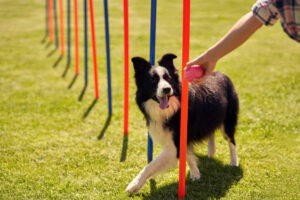We’ve all heard dog noises and sounds, but have you ever wondered what they mean?
Dogs employ more than just barking to interact with us; the distinct sounds they make hold a world of meaning! From snarling and whining to yelping and whimpering, our furry friends are adept at conveying their feelings. With practice, owners can discern if canine noises express delight or distress, hunger or hostility.
In this article, we’ll review the different dog noises and sounds, what they mean, and how to respond appropriately.
Dog Noises and What they Mean
While it’s true that most of a dog’s vocalizations are indicative of distress, they can also be an expression of joy.
This section will explore dog noises and sounds that are unmistakable, as well as the deeper meanings they hold.
Barking
A dog’s bark is a crucial means of communication, conveying feelings ranging from joy to fear, irritation, or rage. Depending on the context, it can make quite different noises too.
For instance, barking due to distress often takes the form of high-pitched and repeated vocalizations that increase in pitch as anxiety grows. Boredom barking can be monotonous, while an alert bark tends to be sharp and staccato. Lastly, alarm barking is usually loud and deep.
Growling
Growling is a dog’s way of communicating displeasure or warning others to keep their distance. It can range from low and rumbling to loud, sharp barks and snarls.
Most dog owners recognize growling as a sign that major aggression is on the way if you continue doing whatever you’re doing or whatever is going on around your dog.
Rather than taking offense at your dog’s snarl, listen to him and figure out ways to help him feel more at ease in the situation. You can also examine your dog’s body language to determine whether you should separate them or encourage them.
Whining
Your pup’s whimpering, whining, and sobbing voices can signify a myriad of issues. Possibly your canine is vocalizing as he needs or wants something like food or care; maybe he is scared, distressed, or hurting – in all these cases dogs tend to make noises constantly too.
Howling
Wolves and dogs howl for similar reasons, with the former using it to communicate with their packs and potentially expressing emotions we have yet to understand.
Your pup may be attempting to share something they can’t otherwise say if they keep vocalizing when you leave them behind. It’s also possible that this behavior is contagious among pups much like wolves; in which case, desensitization or counterconditioning might help your furry friend settle down when the initial sound stops.
Coughing
Dogs often explore the world around them through their noses, and sometimes they can accidentally inhale particles that don’t agree with their bodies, resulting in a cough.
However, this is usually an isolated incident, so watch for any recurrences. Kennel cough is another condition your pup may be exposed to if there are other dogs present. Though it’s curable, its effects become more severe as your dog ages.
Conclusion
Understanding your dog’s vocalizations is critical if you want to truly understand your pet. After all, if your pet is speaking with you, you’ll improve your bond with them if you make an attempt to understand what they’re saying.
That said, keep in mind that if your dog exhibits behavioral issues related to noises, you should visit your veterinarian or a qualified animal behaviorist to determine the underlying cause and how to remedy it.
To learn more about dogs and dog behavior, visit the PetFitness blog today!







